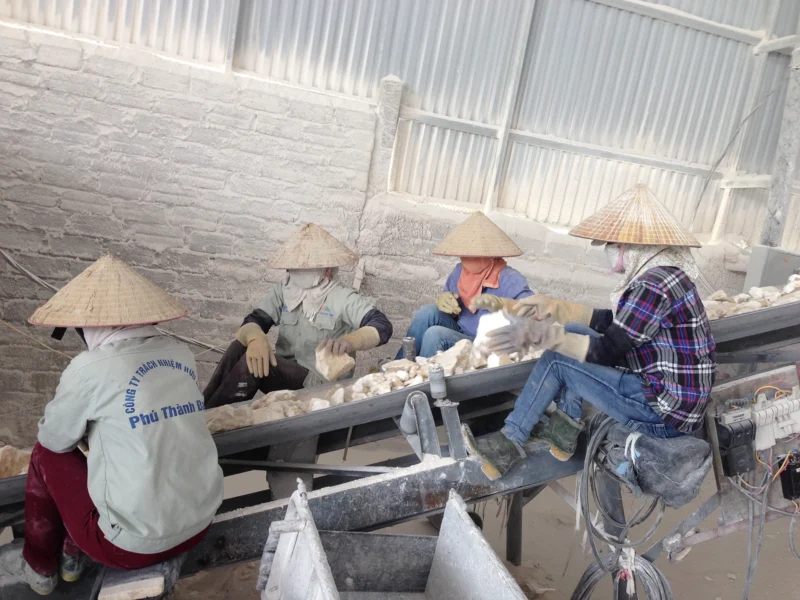At the seminar titled “Industrial Lime Production Technology – Solutions for Energy and Cost Savings in Cement Production” held on May 23, 2011, Mr. Le Van Toi, M.Sc., Director of the Department of Construction Materials under the Ministry of Construction, presented an overview of Vietnam’s lime production industry, highlighting its current status and outlining development orientations for industrial lime production in the near future.
Current Status of Lime Production in Vietnam
Artisanal Lime Production
Manual lime production remains a long-standing traditional craft in many localities, playing an important role in local economic development and job creation. These operations are typically run by cooperatives, private households, and a few joint-stock companies. They primarily use continuous lime kilns with an average capacity of 5,000 tons/year per kiln and field kilns with an average capacity ranging from 500 to 1,000 tons/year per kiln. According to the Department of Construction Materials, the total capacity of artisanal lime kilns nationwide is approximately 600,000 tons/year.
Industrial-Scale Production and Investment
In recent years, several enterprises have invested in upgrading their facilities to industrial-scale lime production, aiming to enhance product quality and meet both domestic and export demands. The total production capacity of industrial-scale lime plants in Vietnam currently stands at around 2.9 million tons/year.
There are three automated, industrial-scale vertical kiln lime plants currently in operation, each with a capacity of 150,000 tons/year. These include one facility in Hoanh Bo (Quang Ninh) with a capacity of 50,000 tons/year, one in Bim Son (Thanh Hoa) with a capacity of 60,000 tons/year, and one in Ba Ria–Vung Tau (under VNSTEEL), which supplies lump lime for the steel industry, with a capacity of 40,000 tons/year.
Additionally, seven more large-scale industrial lime production facilities utilizing vertical kiln technology were under construction and expected to become operational between late 2011 and 2012, with a combined capacity of 1.78 million tons/year.
Development Potential and Market Demand
Raw Materials and Fuel Resources
Vietnam possesses abundant limestone resources, although distribution is uneven, with deposits concentrated from the northern region to Quang Binh province. Excluding protected areas where mining is prohibited, exploitable limestone reserves are estimated in the hundreds of billions of tons.
Based on surveys of 274 mines, total limestone resources amount to 44.74 billion tons, including 12.56 billion tons of B+C1+C2-grade reserves and 32.18 billion tons of P-grade resources. Of these, 42 mines (1.67 billion tons) are located in restricted or protected zones. Therefore, 232 mines with a total of 43.07 billion tons remain available for industrial use, including cement production.
Vietnam also has diverse coal resources, mainly high-quality anthracite. Total coal reserves are approximately 3.5 billion tons, concentrated in areas such as Quang Ninh (3.3 billion tons, including 195 million tons of surface coal), Thai Nguyen (80 million tons), and Na Duong in Lang Son (100 million tons).
Domestic and Export Demand Forecast
Demand for lime and precipitated calcium carbonate (PCC) in Vietnam has been growing steadily at an average annual rate of 15–20%. Calcined lime is used as a raw material in various industries, including construction, manufacturing, and consumer goods. Key sectors include:
-
Paper (printing, writing, packaging, coated paper)
-
Paints, pigments, rubber, fertilizers, chemicals
-
Environmental treatment
-
Steel production
-
Ceramics, plastics, and aquaculture
Projected demand for lime across industries in Vietnam is as follows:
-
2015: 4.068 million tons (3.068 million domestic; 1.0 million export)
-
2020: 7.28 million tons (5.28 million domestic; 2.0 million export)
-
2025: 9.91 million tons (7.41 million domestic; 2.5 million export)
Development Orientation for Industrial Lime Production (2020–2030)
The key objectives of the national industrial lime development plan for the 2020–2030 period are:
-
Ensuring a balanced supply–demand structure, not only for construction needs but also for other sectors and export markets;
-
Promoting sustainable development through resource efficiency, environmental protection, and preservation of cultural heritage, natural landscapes, and national security.
Investment Principles:
-
Ensure economic efficiency and competitive product pricing on regional and global scales;
-
Promote rational resource use and environmental protection;
-
Prioritize upgrading existing vertical kiln plants that cannot transition to rotary kiln technology to preserve existing infrastructure and labor resources.
Technology Guidelines:
-
Adopt advanced, highly automated technologies and equipment;
-
Ensure high-quality, stable products at competitive costs;
-
Encourage product diversification.
Production Scale:
-
Promote selective investment in large-scale projects using modern technology;
-
Tailor capacity to market demand, particularly in areas with low consumption potential.
Planning and Layout:
-
Site production facilities in areas with strong raw material availability and supporting infrastructure;
-
Align plant locations with regional demand and national planning, including export potential;
-
Develop lime production as a supporting industry for others (e.g., steel, bauxite), concentrated in limestone-rich regions.
Conclusion
Mr. Le Van Toi’s presentation offers practical insights into the current state and development trajectory of Vietnam’s lime production sector. It highlights key issues, opportunities, and challenges—especially the need to balance economic growth with environmental stewardship. This is a critical consideration for all stakeholders involved in resource exploitation and industrial development.
